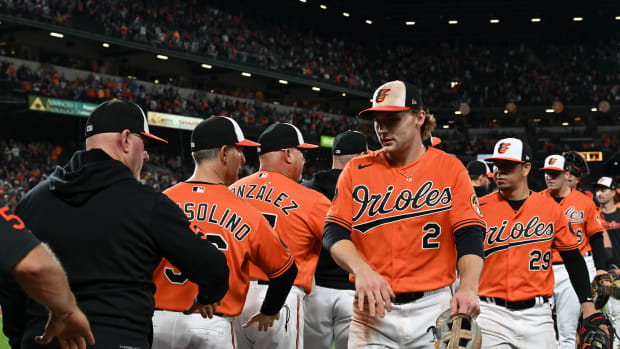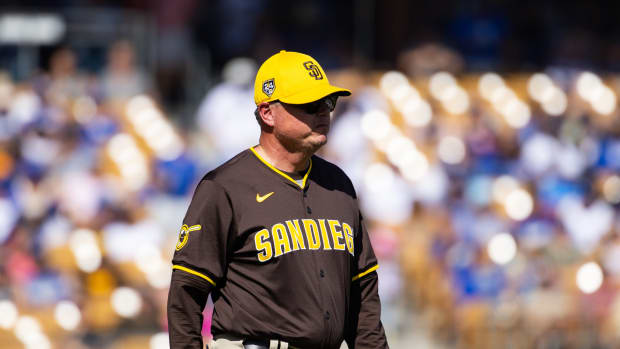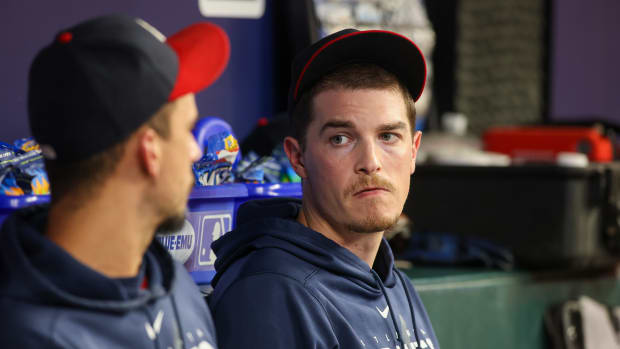How Wil Myers Overhauled His Swing to Join the Launch Angle Revolution
PEORIA, Ariz. — Wil Myers, 27 years old, an All-Star sitting on an $83 million contract, faced no compelling reason to change the way that he hits. That he did change last year, quietly joining the legions of major leaguers who aim to hit the ball high and far every time, is a case study in how the game has changed dramatically in the past three years.
In theory and practice, the craft of hitting a baseball never has been more of an airborne pursuit than it is today, a lightning-fast shift I examine at length in the current issue of SI. Myers, the San Diego Padres outfielder, is a proxy for why this insurgency has taken over the game, batter by batter.
First, early adopters created buzz with wildly successful mid-career swing changes. Think Jose Bautista, Justin Turner, Josh Donaldson, Daniel Murphy, J.D. Martinez, etc. Then “launch angle” became part of not only baseball’s vocabulary, but also its sacred metrics. Now, the idea of hitting the ball in the air is mainstream. Though you, the fan, may not like what it’s done to the aesthetics of the game, it is too validated by data for hitters to ignore—hitters just like Myers.
“The launch angle is really big,” Myers said. “I think there’s a lot to that. There are a lot of people out there who are skeptical of it, but I really believe there’s a lot to that. You definitely want to hit the ball in the air. You want to stay away from groundballs.
“There’s four infielders and three outfielders, so it only makes sense to hit the ball where there’s only three people and more room.”
Like most hitters, Meyers had spent his entire life training so that a perfectly struck ball off a batting tee hit the back net of a batting tunnel—the equivalent of a line drive whizzing by a pitcher’s head. Nobody stopped to ask one simple question: Why? Such a well-struck ball could be nothing but a single. In today’s game, when singles are more infrequent than ever (as a percentage of hits), why would you practice hitting singles? Who gets paid to hit singles? Nobody, especially Myers, who is a 6' 3", 205-pound corner player.
So Myers, working on his own before last season, without a swing “guru,” began to re-train his swing and his approach. He changed only because he could see what was happening around him.
He stopped trying to hit the back of the cage. Instead, he hung targets off the top of the net, near the back of the tunnel. Every time he hit balls off the tee or in BP he tried to hit through the targets and into the top of the net, something that for years even the best hitting coaches advised against. He did this all winter and all through the season.
How did it turn out for him? Check out the results:
Year | Launch Angle | Groundballs | GO:AO | SLG % | K | HR |
2016 | 10.2 | 201 | 1.20 | .461 | 160 | 28 |
2017 | 15.2 | 153 | 0.79 | .464 | 180 | 30 |
The game rewards slugging, not hitting for average. The incentive for hitters is irrefutable. For his career, Myers hits .283 and slugs .592 when he hits the ball on the ground. He hits .407 and slugs .857 when he hits it in the air.
Last season he succeeded in getting more balls in the air. Myers increased his average launch angle by almost 50 percent. He cut his groundballs by almost 25 percent. For the first time in his career he made fewer outs on the ground than in the air. His slugging and his home runs barely increased and, as with many hitters who try to get the ball in the air, his strikeouts increased.
“Well, I didn’t have a great year,” he admitted.
Myers identified two problems that had nothing to do with his swing. First, he discovered the vision in his left eye was only 20/35. He found out late last season, when he decided, “I’m not seeing the slider well,” and asked for a follow-up to the eye exam he had before the season began.
He was fitted with contacts just before spring training this year. After needing two weeks just to get comfortable putting them in, he tried them early in camp.
Said Myers, before using them in a game for the first time, “I have noticed when I’m looking in the distance, like looking at the scoreboard or somebody’s number from a distance, I can pick it up a lot clearer than I used to.”
The other problem was with his head. Myers saw a sports psychologist this past offseason—sometimes while hitting in the cage. Why?
“Just dealing with failure,” he said. “I’m a guy that likes to jump to a quick fix when something doesn’t work. If that doesn’t work I jump to another quick fix, as opposed to sticking with a foundation. I’ve worked very hard this offseason. I hit with my sports psychologist to focus on the foundation that I’m trying to lay, instead of trying something each and every day, because I don’t have a ton of patience. When something doesn’t work I try to change to something else, and that is the worst way to try to hit.
“For me I feel like I’ve never lacked the physical ability. It’s always been right here [tapping his head]. I needed to take a step to get better at that. I feel I’m too good to be an average player in the big leagues.”
While attending to his vision and mental approach, Myers has continued to work on launching more balls in the air. It’s only spring training, but Myers is off to a .367/.387/.600 start.
The average MLB launch angle has increased every season since StatCast began tracking it in 2015: 10.1 to 10.8 to 11.0. You can have all kinds of fun diving into launch angle and exit velocity numbers. The Nationals’ Murphy, for instance, thinks optimum contact is 25 degrees at 98 mph. Last year, hitters who matched Murphy’s Law hit .462 with a .728 wOBA. Impressive, but not nearly as good as if they raised their launch angle slightly higher, to 29 degrees, with the same exit velocity: .566 and 1.096.
More esoterica: the average launch angle of a home run was 28.1 degrees, exactly what it was in 2016. The Royals, former practitioners of small ball, jumped on board with the largest increase in average launch angle last year (+3.2 degrees). The Mets have had the highest average launch angle over the past three years (13.1).
Among players with at least 10 home runs, Gerardo Parra hit his dingers with the highest average launch angle (33.1)—yes, Gerardo Parra is the king of the moon shots! Who knew?—and Mookie Betts hit his with the lowest (23.1)—not the preferred exit path to clear the Green Monster at Fenway Park.
But here’s what you should know about this new toy called launch angle: most hitters don’t think in terms of specific launch angle measurements. Myers is that typical hitter. His quest is about developing the proper approach rather than the measurements of it.
“I wasn’t going in the cage trying to find out what degree I was hitting the ball at,” he said. “I was more so just trying to get the ball in the air. It had nothing to do with me perfecting an angle. It was just trying just to get the ball in the air. When I take BP I try to hit homers to centerfield every single time. That’s what I want my swing to be geared toward: a home run to centerfield every time.
“I did a lot on my own. I also talked to J-Wash [Johnny Washington], our assistant hitting coach. He’s big on the launch angles, trying to take bits and pieces of it. I’m not a guy who’s really trying to get under balls. For me it’s more that it’s not thinking down on the ball like I used to. It’s more trying to get level with the ball instead of the uppercut.
“Just try to match that plane. The ball is going down, so you need to meet that plane with somewhat of an upper angle, not straight down – there’s not a ton of success trying to meet the ball just like that. You have to hit it exactly perfect.”
Myers wasn’t trying to match a certain launch angle when he began hitting balls through targets hanging from the cage.
“I wasn’t trying to find out what degree I was hitting the ball,” he said. “I was more just trying to get the ball in the air. It had nothing to do with me perfecting an angle. When I take BP I try to hit homers to centerfield every single time. That’s what I want me swing to be geared toward: a home run to centerfield every time.”
Myers is now teammates again with another hitting convert, Eric Hosmer, who leap-frogged Myers as the highest-paid player in franchise history with his $144 million free agent deal. Pundits screamed it was an overpay for a groundball hitter. But as Hosmer revealed to me in my SI story, he quietly joined the Launch Angle Revolution midway through last season after a miserable start. Like Myers, he looked around baseball, saw what was happening, and jumped on board. In the offseason he hit one day in his Miami cage with Martinez and Robert Van Scoyoc, Martinez’s hitting guru who since was hired by Arizona as its Hitting Strategist. Hosmer mostly uses his brother as his swing coach.
“It’s a completely different swing path than anybody’s ever been taught,” Hosmer said. “My whole thing is creating that separation and getting the barrel flat and then a turn with the shoulders instead of being so handsy. That’s the move. Like Dan Murphy says, ‘Get on the same plane as the baseball as early as you can.’”
This winter he studied the moves of Joey Votto, Turner and Martinez.
Stories like Myers’ story—the quiet side of the revolution—are happening all over baseball. Diamondbacks third baseman Jake Lamb, for instance, after a decent 2015 season (.263/.331/.386), changed his swing because of what he saw from teammate A.J. Pollock, who adopted some of the principles of hitting guru Bobby Tewksbary.
“That was from just watching A.J.,” Lamb said his inspiration to change. “I told him, ‘I feel like you’re not sitting on pitches, but you’re on time for any pitch.’ He goes, ‘Yeah!’ I said, ‘I can’t do that. I have to pick my pitches.’ I had to be perfect every time.
“I read on Tewksbary—I never met the guy—and worked with some guys back home who were doing the same stuff. This year I’ve been working with Robert, J.D.’s guy who was here last year.”
With a new swing in 2016, Lamb busted out by slugging .509 and hitting 29 homers. He followed that last year with a .487 slugging percentage and 30 home runs. In two years he cut his groundball rate from 45% to 41%—without thinking about his average launch angle, which didn’t move all that much from one year to the next (11.4, 10.4, 12.0).
“I argue with Pollock all the time about this,” Lamb said. “I think if you preach ‘Get the ball in the air,’ a guy like me, I’ll do it the wrong way. I’ll try to do everything I can. Some people are different. I think I get the ball in the air through my work on my path.”
What Myers and Lamb did no longer is extraordinary. This is state of the art.
“I’m not oblivious to the numbers,” Lamb said when asked why he changed. “I’m obsessed with being the best player I can be. After the ’15 season I said, ‘There’s a lot left in the tank.’ And even after last year—it was a fun year: we won, made my first All-Star Game—there’s still a lot left in the tank. It comes from within.
“It doesn’t just click. You have to completely change stuff. I made an adjustment to be more consistent with my timing and make sure my barrel is on plane longer—entering the zone earlier and exiting later—and it helped. When the offseason comes and you can accept, ‘Hey, I’m going to change it up. I know there’s more in the tank,’ I feel there’s a way we can find it.’”
Said Cubs manager Joe Maddon, “We’re at the point now, where when you get a good young hitter into your system, especially a lefthanded hitter where shifts can take away the pull side, you face a decision: Do you want the guy to be a hitter who can move the ball to all fields, or do you want a hitter who is going to try to hit over the shift?”
That question is being answered at every level, from the majors to Little League, and it is overwhelmingly being answered in a way that is giving us a game that emphasizes the flyball, even if it means fewer balls in play and fewer small ball tactics.
The game encourages selling out and going big. Home runs (and their corollary, strikeouts) are to baseball what the three-point shot is to the NBA. Data have changed these sports. This season the NBA will set a record for three-point shots attempted per game for a seventh consecutive season; the bigger payoff is worth it, like trying to hit a homer to centerfield with two strikes. Still, overall shooting percentage in the league matches the best it’s been in 22 years. In baseball, the hard-hit ball percentage was the highest in a decade. The game has changed, and this is only the beginning as more hitters like Myers jump on board.
“Oh, yeah,” said Rangers hitting coach Anthony Iapoce. “The strikeouts have broken a record every year since ’05. It’s nuts. The home runs are going up. You’re going to have more guys going for it, and all this information is being processed at the academies and travel circuit. Those kids are nine years from getting here. They’re being trained at a young age to launch.”



































